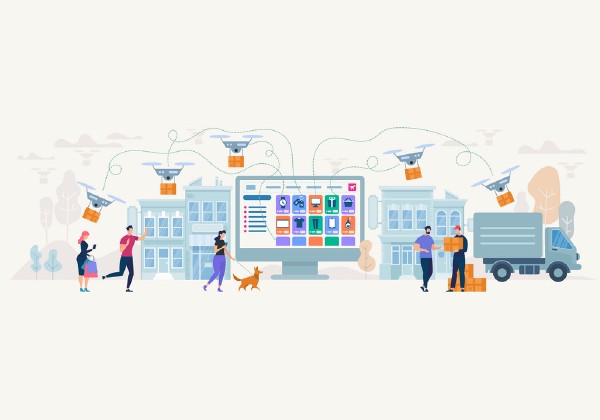8 Examples of IoT applications in logistics
Published on Wednesday, Sep 16, 2020The Internet of Things (IoT solutions) applications in logistics solves a large number of problems in typical supply chain from warehousing to fleet management and cargo tracking, thus becoming the real power to promote the digital transformation of the industry.

The logistics and transportation industries are the main industries that adopt the Internet of Things (IoT solutions) on a large scale. With the improvement of logistics operation speed and accuracy standards, technology can help companies ensure excellent service quality while optimizing costs. More importantly, the logistics application of the Internet of Things (IoT solutions) solves a large number of problems in the typical supply chain from warehousing to fleet management and cargo tracking, thus becoming the real power to promote the digital transformation of the industry. The following 8 major applications show how to implement IoT technology for end-to-end supply chain management.
Inventory tracking and analysis
Companies can use multiple methods for inventory tracking. Traditional barcodes are suitable for basic inventory management, while smart tags and RFID tags provide a wider range of automation and analysis functions. These IoT-powered methods use microchips in RFID tags, which can carry all the product information you need, and update them in real time to fully understand inventory dynamics. They can also improve accuracy and reduce error-prone manual operations by automatically scanning incoming and outgoing items.
Optimize storage
Warehouse management benefits greatly from remote storage environment monitoring. By using IoT sensors and RFID readers, companies can easily set rules to maintain stable temperature and humidity levels in the facility, as well as to ensure safety, detect fires, etc. You can also track the activity level of warehouse machinery to optimize its workload. Combined with the above application (inventory tracking), you can easily observe and coordinate warehousing operations driven by the Internet of Things (IoT solutions), and even reach the level of individual physical assets and stored items.
Real-time fleet management
Fleet management is probably the most popular logistics IoT solution. Using GPS or satellite trackers to collect remote data from vehicles can improve driver compliance, improve the accuracy of delivery time, and ensure the safety of drivers and cargo. The fleet management solution also has fuel consumption monitoring and driver behavior monitoring functions. These data can be used to better understand the driver’s personal information and create a personalized training plan to address the driver’s career development and job satisfaction.

Predictive maintenance
Companies operating large fleets, ships or warehouse equipment often struggle to optimize their maintenance costs. The company could lose millions of dollars in profits due to failures and unplanned downtime. And this is where predictive maintenance-another popular solution for the Internet of Things (IoT solutions)-comes into play. Install sensors for various machines to monitor heating, vibration, noise and other parameters, enabling engineers to detect early signs of failure and prevent serious damage. In addition, the use of vehicle health checks also helps reduce the number of physical checks.
Cargo integrity monitoring
Cargo integrity makes logistics companies more preferential to adopt the Internet of Things (IoT solutions), because it not only directly affects operational efficiency, but also affects customer satisfaction. RFID tags can be used to monitor the transportation environment of individual items or smart containers, which is especially useful for perishable items. These RFID tags also help track theft or improper operation. In addition, cargo monitoring RFID tags and applications are part of the widely used end-to-end delivery tracking solution.
End-to-end delivery tracking
IoT solutions collect a lot of different data, so it is equally important to create user-friendly dashboards that display this data. In the logistics field, one of the biggest challenges is to integrate the different stages of supply chain management into a single application. And this is why modern IoT platforms provide flexible and configurable data dashboard functions. They enable managers to easily grasp all the operational data collected by IoT sensors and devices (such as RFID tags and RFID readers) and meet customer needs, allowing customers to easily see how long their goods will arrive.
Last mile delivery innovation
Some of the most promising IoT innovations in logistics will occur in the last mile of delivery services. For example, for many companies, achieving same-day delivery is still a luxury, although customers are willing to pay extra for this. The only reliable way to successfully provide this service is to use technology to speed up and automate the end-to-end supply chain workflow. Once the backbone logistics operations are digitized, through the use of mobile applications, predictive replenishment, smart buttons and drones, there will be more opportunities to speed up the delivery of the last mile.

Integration of IoT and existing business applications
Last but not least, many companies have encountered difficulties in how to effectively integrate IoT solutions with existing business applications (such as ERP, accounting, human resource management, etc.). This integration requires additional development effort, and even IoT solution providers may be unable or unwilling to provide it. In order to simplify this process, companies need to understand and start leveraging modern cloud-based architectures and centralized data integration. Over time, your IoT application ecosystem is likely to expand rapidly, so if your applications are connected to each other through a single enterprise-level IoT platform, it will help. Using the IoT platform can greatly simplify the data synchronization settings between various applications and provide you with the necessary tools to extend the IoT solution, and manage different applications through a single interface and integrate them with external systems.
Now is the time for logistics companies to develop an overall strategy around their IoT plans. Modern technologies provide real breakthrough capabilities and elevate supply chain management to a whole new level, but they should not be applied blindly. While supporting these new IoT capabilities, the tight integration between all links in the supply chain will help your company strike the perfect balance between innovation speed, flexibility and reliability.